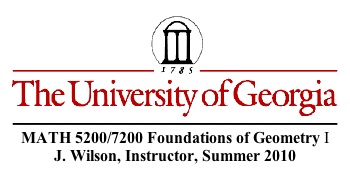

Overview of Section 3.1 Areas of Polygons
Concept of area
Unit length and unit square as measures of length and area
Discussion of Geoboard.
Suggestion: Do a Google search for Geoboard information, lessons, activities.
Pick's Theorem. This is a theorem that allows one to determine the area of figures with vertices on the pegs of a Geoboard by counting the number of pegs on the Boundary (B) and counting the number of pegs on the Interior (I). The area is given by
Link for a Geoboard applet
NCTM Illuminations Project Investigating Pick's Theorem
In particular look at the NCTM Illuminations site Activity Sheet for Discovering Pick's Theorem. It is a PDF file that will download to your computer.
Approximating areas of irregular shapes using a grid: Inner area < area < outer area
Axioms for area
Axiom 3.1: The area of any polygonal region (a polygon and its interior) is a unique positive real number.
Axiom 3.2: The area of any point or line segment is 0.
Axiom 3.3: Congruent polygonal regions have the same area.
Axiom 3.4: Area is additive. That is, if we can divide a figure into non-overlapping parts, or parts that share lines or line segments, then its area is the sum of the areas of the parts
Theorem 3.1 Area of a rectangle
The area of rectangle with sides of length a and b is ab.
Theorem 3.1 is justified/proved by using the axioms, in particular Axiom 3.5. In turn, then the theorem for the area of a rectangle will be used to derive formulas for the areas of other polygons.
Areas of a parallelogram, a triangle, and a trapezoid.
Dissection: a strategy of dividing an area into parts and possibly reassembling them
Theorem 3.2 Area of a parallelogram
The area of a parallelogram equals the product of the length of the base and the corresponding height.
Corollary 3.2. Any parallelogram with base b and height h has the same area.
Theorem 3.3 Area of a triangle
The area of a triangle is half the product of the length of the base and its corresponding height.
Open GSP file for three implied derivations of the area formula for the triangle.
Can you find other derivations (proofs)?
Corollary 3.3. Any triangle with base of length b and corresponding height h will have the same area. See page 2 of the GSP file.
Any of the three bases and the corresponding height can be used to find the area. Hence for any triangle there are three equivalent area formulas.
Suggestion: Cut out a triangle from a sheet of paper and use paper folding to derive the area formula as guided by something similar to the third choice.
Suggestion: Draw a triangle on a sheet of paper (do not cut out) and use paper folding to derive the area formula.
Example 3.1 and Now Solve This 3.2: Redrawing a border problems. Open GSP file
Triangles created by medians.
Theorem: A median divides the area of a triangle into two equal areas.
Proof: By definition the median is a segment from a vertex to the midpoint of the opposite side. Therefore the two triangles formed by a median have the same base. The altitude from that vertex to the opposite side would be the same for each of the two triangles. Therefore they have the same area.
Theorem: The six triangles created by drawing the three medians to a triangle all have the same area.
Proof:
By the previous theorem
A(1) = A(2)
A(3) = A(4)
A(5) = A(6)
But, A(1) + A(2) + A(6) = 1/2 A(triangle). So A(6) = 1/2 A(triangle) - 2A(1)
Likewise, A(1) + A(2) + A(3) = 1/2 A(triangle). So A(3) = 1/2 A(triangle) - 2A(1)
Therefore, A(6) = A(3). In a similar manner we can get A(1) = A(4) and A(2) = A(5)
Hence A(2) = A(1) = A(4) = A(3) = A(6) = A(5)
Theorem: In triangle ABC with medians AM, BN, and CP, prove that N and P are equidistant from AM.
Hint: Find triangles with base AM having altitudes to N and P.
Area of a trapezoid
There are many different ways to derive the formula for the area of a trapezoid:
Dissection into triangles
Showing same area as a related rectangle
Using area of a related parallelogram
Difference of two triangles
Problem Set 3.1